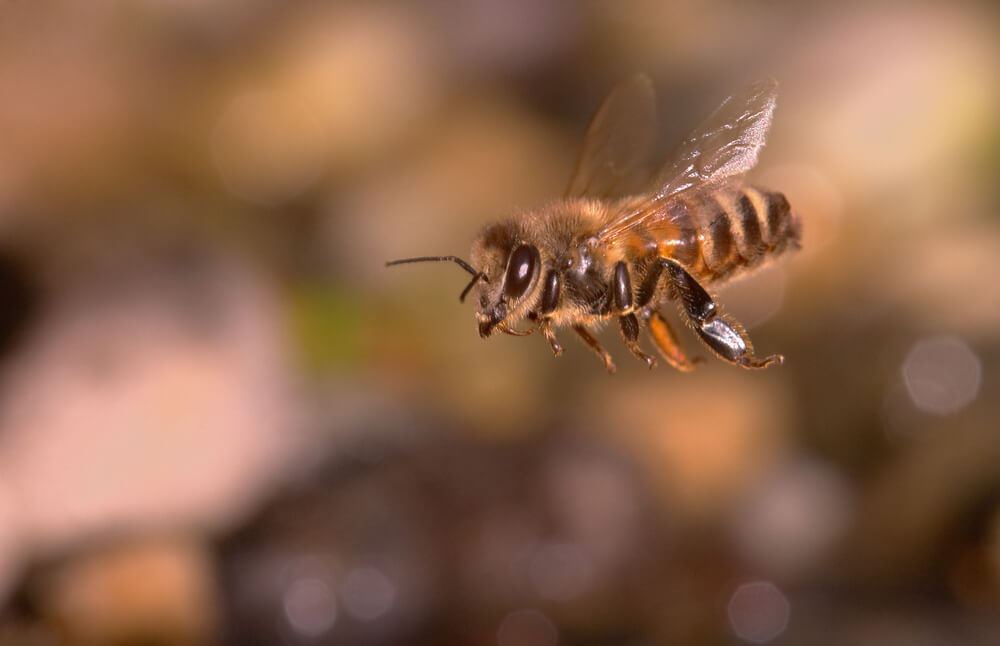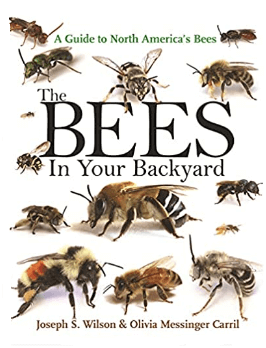Table of Contents:
What Do Killer Bees Look Like?
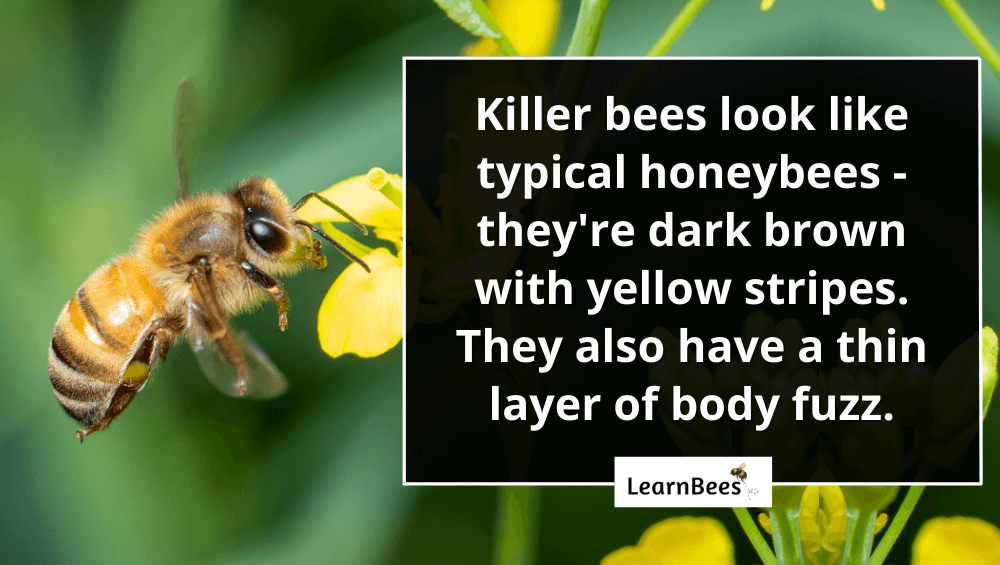
Killer bees are dark brown with yellow stripes. If you look closely, you’ll notice that their bodies are covered in a fine layer of hair.
But here’s the important part:
Killer bees are actually a type of honeybee.
That’s right. They’re the same type of bee that produces the raw honey you find online, at the grocery store, and farmer’s markets.
However, most beekeepers don’t work with killer bees due to their defensive nature. Instead, beekeepers work with western honeybees (Apis mellifera) because they’re much more gentle-natured and can produce large amounts of honey.
And here’s the thing:
The term “killer bee” is just a nickname. Their proper name is Africanized honeybees (Apis mellifera scutellata Lepeletier).
Now you might be asking…
Why are they called killer bees?
Killer bees have earned their nickname because they’ve been known to chase people over 1,000 feet. That said, killer bees typically only chase people or pets if they step within 50 feet of their nest.

Remember:
Killer bees are honey producers. They can make dozens of pounds of honey per year. As such, this makes them a target for many honey-loving creatures, such as raccoons, bears, and other insects.
In fact, a hungry bear can demolish an entire killer bee nest in a matter of seconds.
So by nature, killer bees are defensive over their nests and may mistake humans and pets for potential threats.
The only problem?
Sometimes people or pets don’t realize they’ve stumbled upon a killer bee nest. As a result, they may get chased and stung in large numbers – which can be potentially life-threatening.
But surprisingly enough:
Killer bees are a man-made bee species.
They were created in the 1950s as a part of a science experiment. The Brazilian government commissioned a biologist named Warwick E. Kerr to create a bee that made more honey.
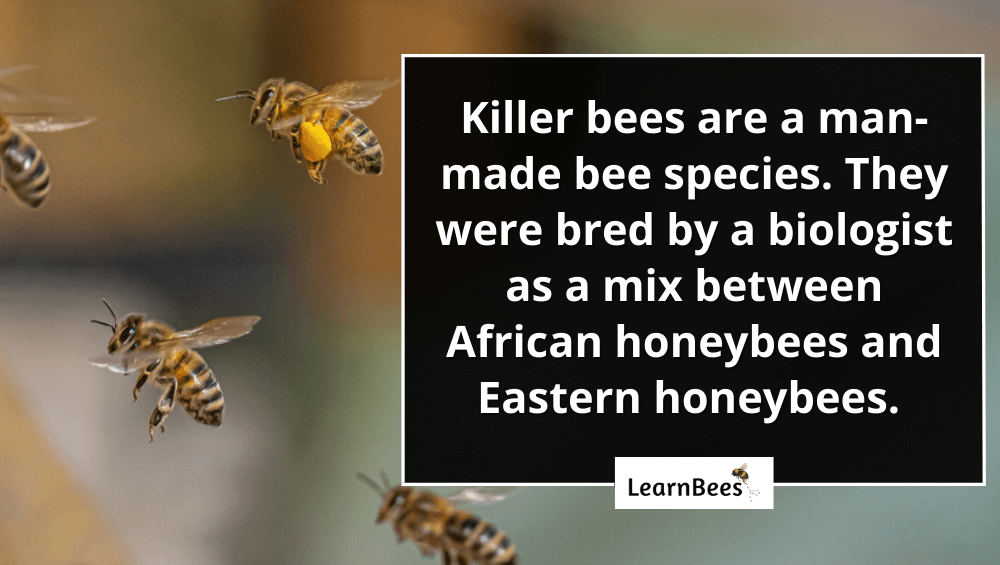
Dr. Kerr wanted to create a bee that could withstand the Brazilian heat and weather conditions. So, he bred European honeybees with African honeybees, which made the “killer honeybees” we know today.
At first, the experiment seemed to be a success. The bees were faring well in the Brazilian climate and producing plenty of honey.
But there was one massive downside.
The Africanized honeybees – or “killer bees” – were highly defensive over their nests.
Even worse?
Somehow, under hazy conditions, thousands of these killer bees managed to escape. They swarmed through South and Central America until they eventually reached the United States.
That brings us to our next question…
Where Do Killer Bees Live?
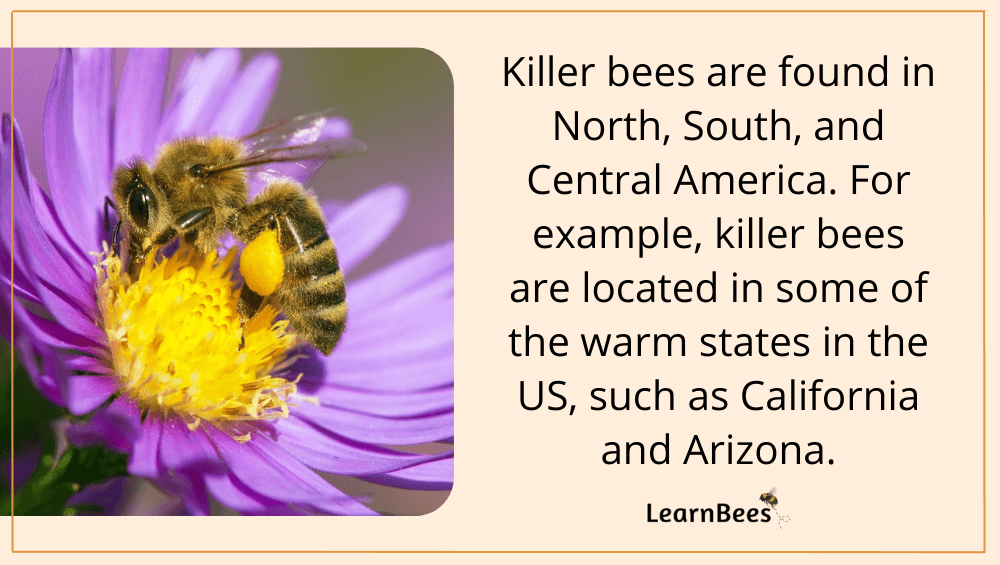
Killer bees are located in South America, North America, and Central America.
More specifically, killer bees can be found in the following states:
- Arkansas
- Arizona
- California
- Florida
- Oklahoma
- Texas
- Louisiana
- New Mexico
- Nevada
Africanized killer bees are considered an invasive bee species. They tend to have smaller colony sizes than western honeybees. Smaller colonies allow them to build smaller nests in more areas. You may find their nests in trees, buildings, or even abandoned cars.
But keep in mind:
Killer bees are a type of honeybee. This makes it hard to tell them apart from western honeybees, which are more gentle-natured.
That said, killer bees can often be identified by their aggression level.
For example, western honeybees will usually leave you alone after you step 10 or 15 feet away from their hive. In contrast, killer bees are known to chase people in large numbers, sometimes following people over 1,000 feet away from their nest.
Big difference.
But thanks to their genes, killer bees are less likely to survive in colder climates than western honeybees. They prefer warm, humid climates like the ones found in South and Central America.
What Do Killer Bees Eat?
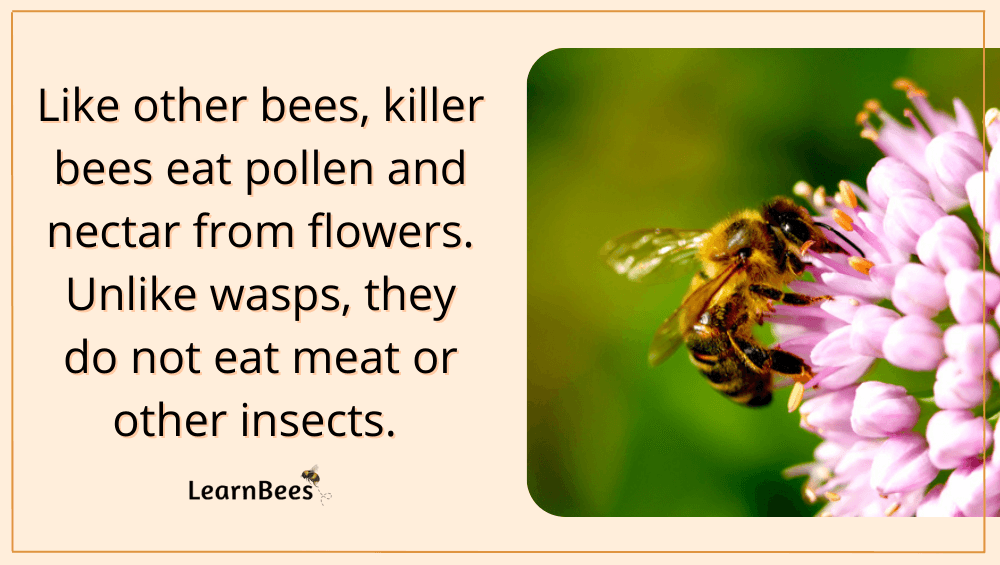
The main difference between killer bees and other bee species is their aggression level.
Besides that, killer bees have similar eating, drinking, and nesting habits as other honeybees. They eat the pollen and nectar they collect from flowers.
Nectar is a sugary liquid produced by plants. It gives bees the carbohydrates needed to provide them with energy. Protein is the yellow powdery substance produced by plants. It supplies the bees with the protein they need to grow healthy and strong.
And despite popular belief:
Killer bees don’t eat meat or other insects.
They don’t attack humans, pets, or children to eat them. Instead, they rely on flowers as their food source.
Also, killer bees produce honey for food storage during nectar dearths. Nectar dearths occur when flowers are scarce, such as during winter or summer droughts.
With that in mind, killer bees are known to produce less honey than western honeybees. This is believed to be true because they’re native to a warm environment where flowers are available throughout the year. As a result, they don’t produce as much honey storage.
FAQs on “What Do Killer Bees Look Like?”
- What happens if a killer bee stings you?
- Do killer bees make honey?
- Do killer bees die when they sting?
- Do killer bees want to sting you?
- Where are killer bees in the United States?
- How do you escape the killer bees?
- Can you outrun killer bees?
- Are killer bees aggressive?
- What are killer bees attracted to?
- Do killer bees hurt?
- How many people die from killer bees a year?
- How far north have killer bees been found?
- Do killer bees fly at night?
- What state has the most killer bees?
- Where do killer bees build nests?
- Can you survive a killer bee sting?
- How many times can a killer bee sting before it dies?
What happens if a killer bee stings you?
Killer bee stings are very similar to western honeybee stings. They can result in slight redness and swelling at the sting site area. You may also experience some itching until the sting wound subsides.
People severely allergic to bee stings can experience stronger reactions, such as swelling in other parts of the body, difficulty breathing, and anaphylactic shock.
The main difference between a killer bee sting and a western honeybee sting is that killer bees tend to attack in more significant numbers and chase for longer distances. Multiple bee stings can result in a more severe reaction.
—> Go back to the FAQs on “What Do Killer Bees Look Like?”
More to Explore:
Do killer bees make honey?
Yes, killer bees make honey just like western honeybees. However, they don’t produce as much honey as western honeybees because they’re native to a warm climate where flowers are available throughout the year.
Remember:
Honeybees make honey to help them survive the cold winter months when flower sources are unavailable. It’s food storage for the bees.
Since killer bees live in warmer climates, they don’t produce as much honey. On the other hand, Western honeybees live in both warm and cold temperatures, so they produce plenty of honey in both.
—> Go back to the FAQs on “What Do Killer Bees Look Like?”
More to Explore:
Do killer bees die when they sting?
Yes, like all honeybees, killer bees die when they sting humans because their stinger gets ripped out of their bodies in the process. This happens because human skin is thick, and the bee’s stinger gets caught.
Once the bee tries to fly away, the stinger gets pulled out – taking other vital organs along with it.
—> Go back to the FAQs on “What Do Killer Bees Look Like?”
More to Explore:
Do killer bees want to sting you?
Despite popular belief, killer bees don’t want to sting you. In other words, they don’t sting for no reason.
Instead, they sting because they believe you’re a threat to their nest. You may have walked too close to their hive and startled them.
Unfortunately, humans aren’t able to communicate with killer bees to let them know we come in peace. As a result, the bees may mistakenly believe you’re out to kill them and steal their honey. Remember that killer honeybees are naturally defensive because they have a lot of predators, including birds, bears, and other insects.
—> Go back to the FAQs on “What Do Killer Bees Look Like?”
More to Explore:
Where are killer bees in the United States?
Killer bees are most commonly found in the southern and western United States. This is because they came from South America and eventually made their way up through Mexico and the United States.
They’re located in:
- Arkansas
- Arizona
- California
- Florida
- Oklahoma
- Texas
- Louisiana
- New Mexico
- Nevada
—> Go back to the FAQs on “What Do Killer Bees Look Like?”
More to Explore:
How do you escape the killer bees?
Simply put, you must outrun the bees and find a shelter, such as an enclosed building or car. If no shelter is available, seek bushes or high weeds to run through because this can potentially help deter them.
Once safe, you should alert a local beekeeper and tell them what happened. Many beekeepers will suit up and handle such issues for free.
—> Go back to the FAQs on “What Do Killer Bees Look Like?”
More to Explore:
Can you outrun killer bees?
It depends on how fast you are and if an enclosed shelter is nearby.
Killer honeybees can fly up to 20 miles per hour, so you must be able to run faster than that. If an enclosed shelter is more than a few yards away, it may be challenging to make it there before getting stung several times.
—> Go back to the FAQs on “What Do Killer Bees Look Like?”
More to Explore:
Are killer bees aggressive? Are killer bees still a threat?
Yes, killer bees are known to be aggressive in defending their nests. They’ll attack in large numbers and chase their victim for long distances.
However, they typically don’t attack for no reason. Instead, they become agitated when they feel like their nest is threatened. For example, if you walk too close to their hive or make loud noises near them, they may become defensive and sting you.
—> Go back to the FAQs on “What Do Killer Bees Look Like?”
More to Explore:
- Ground Bees: Are They a Threat to Your Yard?
- Wasps vs. Honeybees: Are They Different?
- Do Bumble Bees Bite?
What are killer bees attracted to?
Like all bees, killer bees are attracted to flowers because it provides them with food. As such, they may build their nests near flower sources.
—> Go back to the FAQs on “What Do Killer Bees Look Like?”
More to Explore:
Do killer bees hurt?
Yes, killer bee stings hurt just as much as regular bee stings. In fact, they may even hurt more because they tend to sting in large numbers. This can result in a large amount of venom being injected into the victim, which can cause serious pain and swelling.
A killer bee sting can even be life-threatening if you’re allergic to bee stings. This is why it’s important to seek medical attention immediately if you’re stung by a bee of any kind.
—> Go back to the FAQs on “What Do Killer Bees Look Like?”
More to Explore:
- Do Carpenter Bees Pollinate?
- How Long Do Bumble Bees Live?
- Honeybees vs. Bumblebees: How Do They Compare?
How many people die from killer bees a year?
Killer Africanized honeybees kill about one to two people per year. They’re rarer than other types of bees and only live in warm climates.
—> Go back to the FAQs on “What Do Killer Bees Look Like?”
More to Explore:
- Do Queen Bees Eat Honey?
- Are Worker Bees Male or Female?
- Queen Bee Versus Worker Bees – How Do They Compare?
How far north have killer bees been found?
Killer bees have been found as north as Sacramento, California. They’re not located in cooler climates because they only adapt to warm weather.
—> Go back to the FAQs on “What Do Killer Bees Look Like?”
More to Explore:
Do killer bees fly at night?
They can fly at night if need be. However, most bees stay inside their nests at night and become active during the day.
—> Go back to the FAQs on “What Do Killer Bees Look Like?”
More to Explore:
What state has the most killer bees?
There has been no research indicating which state has the most killer bees. However, killer bees can be found in California, Nevada, Arkansas, Florida, Oklahoma, Louisiana, Texas, Arizona, and New Mexico.
—> Go back to the FAQs on “What Do Killer Bees Look Like?”
More to Explore:
Where do killer bees build nests?
Killer bees typically build their nests in trees, bushes, and other sheltered areas. They prefer locations that offer them some protection from the elements.
—> Go back to the FAQs on “What Do Killer Bees Look Like?”
More to Explore:
- What Does a Bee Do With Its Tongue?
- Can I Put Baking Soda on Bee Stings?
- Do Yellowjackets Make Honey or Honeycomb?
Can you survive a killer bee sting?
Yes, you can survive a killer bee sting if you don’t get stung too much or have a severe allergic reaction to bee stings. Your best bet is to seek an enclosed shelter to escape the killer bees.
—> Go back to the FAQs on “What Do Killer Bees Look Like?”
More to Explore:
How many times can a killer bee sting before it dies?
Killer bees are a type of honeybee that can only sting humans once. After stinging, the killer bee dies because its stinger gets pulled out during the process. The stinger is attached to important organs, so it kills the bee once it’s removed.
